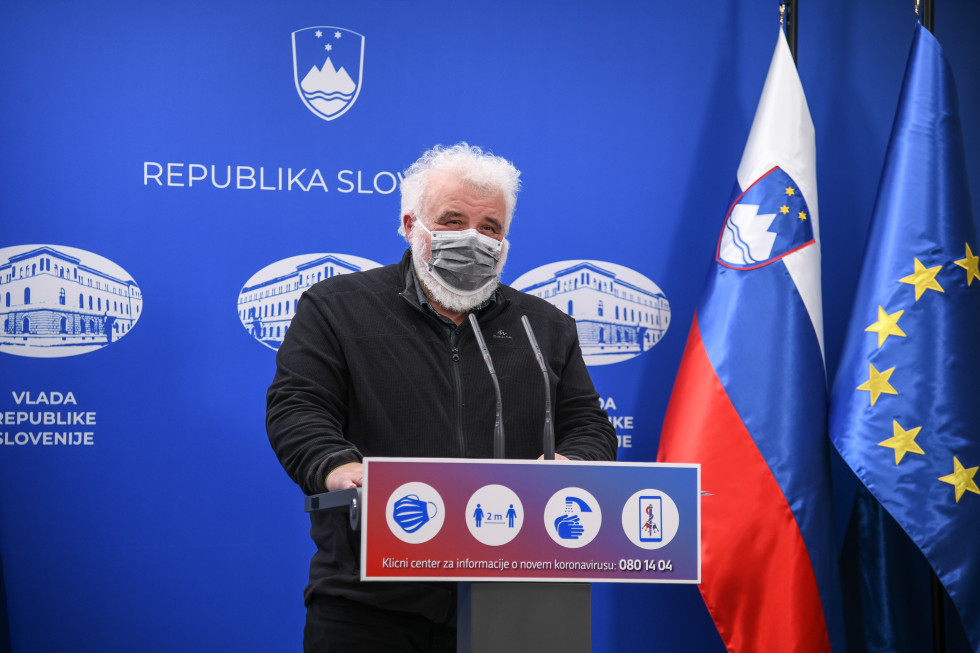High death toll among residents as the state failed to invest in homes for the elderly

Milan Krek | Author Nebojša Tejić/STA
On Sunday, 1,720 PCR tests were performed, of which 368 were positive, and 480 rapid antigen tests, of which 58 were positive. The share of positive PCR tests was 21.4% and of rapid antigen tests 12.1%. In total, 2,200 coronavirus tests were performed and 426 new cases were confirmed, which is a positivity rate of 19.8%. Slovenia has currently around 24,300 COVID-19 positive persons. The average for the past seven days is 1,968 positive cases.
Hospitals discharged 42 patients on Saturday and 38 on Sunday, totalling 80 discharges over the weekend. On Saturday the hospitals admitted 107 persons and on Sunday 73, totalling 180 admissions over the weekend.
As many as 1,205 patients were treated in hospitals yesterday, of which 196, six down from Saturday, needed intensive care. On Sunday, 24 deaths were recorded, of which 19 in hospitals and five in homes for the elderly.
The 14-day incidence rate per 100,000 inhabitants is 1151.8. The 7-day incidence rate per 100,000 inhabitants is 652.8.
The highest numbers of COVID-19 cases were yesterday recorded in the following municipalities: Ljubljana 52, Maribor 37, Ormož 19, Murska Sobota 15, Slovenj Gradec 11, Sevnica 10, and Ajdovščina 16.
There were 23 new cases of COVID-19 among the residents of the homes for the elderly, the majority (15 cases) in the DU Impoljca in the Posavje region. Yesterday saw an additional 49 new cases among the residents and four among the staff of the homes for the elderly. The following two homes for the elderly yesterday reported the highest numbers of new cases among their residents: the DEOS Center Starejših Cerknica (11) and Dom Počitka Mengeš (12). The briefing on the epidemiological data by Mr Kacin was followed by Mr Krek’s presentation.
Mr Krek explained that countries use different methods to collect data on COVID-19 deaths. As there is no standard method, data are not entirely comparable and therefore any direct comparison is not recommended. A uniform classification of deaths linked to COVID-19 is only now being introduced across the world.
The Ministry of Health is in charge of collecting daily data on COVID-19 deaths in hospitals and homes for the elderly. The National Institute of Public Health, however, collects data according to different methods: (i) by comparing databases of COVID-19 positive cases with all deaths, (ii) on the basis of death certificates compiled by doctors – coroners, and (iii) documents recording deaths caused by infectious diseases. Data are collected over a longer period of time and at the end of the year the database of deaths is reviewed and revised.
In 2020, 2,891 deaths linked to COVID-19 were recorded by the National Institute of Public Health, of which 1,682 (58%) were among the residents of homes for the elderly and 1,209 (42%) were among the general population.
The mortality rate in homes for the elderly is high compared to, for example, Italy, where an estimated 35% of residents of homes for the elderly died. One in ten residents of homes for the elderly died due to COVID-19, representing 15% of all COVID-19 positive residents at such homes.
The surplus value of all deaths is the difference between the number of all deaths in individual years.
In 2019, 21,112 deaths were recorded and in 2020 24,265. Hence, in 2020 the surplus value was 3,153 deaths, of which 2,891 were due to COVID-19 and 262 were caused by other factors, accounting for 8% of all deaths.
The highest number of deaths was recorded in the Pomurska region, i.e. 269 per 100,000 inhabitants, reflecting the fact that the Pomurje region with the lowest GDP in Slovenia legs behind in development.
Furthermore, the state did not invest into the homes for the elderly in the last decade. The staff is badly paid and has not been properly trained.
The homes for the elderly are therefore in fact nursing hospitals, which lack suitable premises and an adequate number of appropriate health professionals. It was only a matter of time before the system would collapse; COVID-19 only hastened the process.
In this short period of time between the spring and autumn of this year, the Government and the National Institute of Public Health adopted a number of measures:
- instructions on work in the epidemic were provided to homes for the elderly;
- homes for the elderly readied their own COVID-19 action plans;
- grey, white and red zones were set up at homes for the elderly, which is the most prominent measure;
- training was provided for staff at homes for the elderly;
- new staff was employed (to this end, additional 30 million euro was provided);
- sufficient quantities of protective equipment were purchased,
- healthcare institutions provided knowledge and staff, and assistance in preparations for the second wave;
- staff was transferred between the homes for the elderly to make up for the shortage of personnel;
- students and volunteers for example helped care for the residents;
- measures were imposed in order to prevent staff from coming to work infected with the new coronavirus;
- the majority of the residents and part of the employees at homes for the elderly were vaccinated as the first group in Slovenia;
- plans for the construction of modern homes for the elderly are in the pipeline together with the
- establishment and development of nursing hospitals.
Slovenia, as opposed to other countries that already have nursing hospitals, still lacks such nursing programmes, which is why it has not been able to prevent the virus from spreading.

